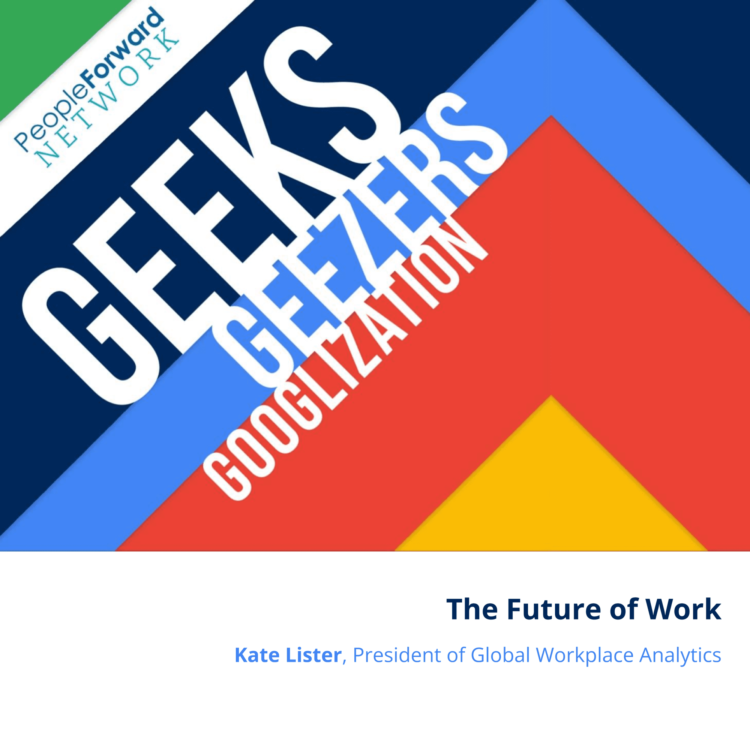The Future of Work with Kate Lister

How Hybrid and Flexible Work Are The Future
In This Episode
Immediately after the abrupt office work shutdown caused by COVID-19 in March 2020, 35 percent of the workforce experienced a shift to remote work, compared to just 6% just days before. Years of employer denials that remote work could work were debunked almost over night. Corporations as well as workers were seeing first hand the many benefits that come along with remote work such as environmental benefits, less traffic accidents, higher morale, and lower operating costs.
Today, over 70% of employees still prefer to work remotely. They are now unwilling to give up the lifestyle and benefits they enjoyed for over 2 years. So what’s up with so many companies and leaders bucking the trend and ordering workers back to the office?
Jason Cochran and Ira Wolfe sat down with Kate Lister, President of Global Workplace Analytics, one of the most respected voices when it comes to the future of work. Kate has been studying the impacts of remote work long before the pandemic. In this episode, she breaks down her research on remote work during the pandemic, where we stand today, and how organizations can be more adaptive. She also briefs us on what the skeptics say are and how to address their concerns.
After Listening You’ll Walk Away With:
Why certain industries can’t go fully remote
How to approach a hybrid model
An inside look at how government officials view remote work
How we viewed remote work before the pandemic vs after
How remote work impacts productivity
Hybrid models and ideas
Flexible approaches that work for the employee and organization
SHRM PDC Recertification Credits are now available for listening to this podcast.
It’s easy CLICK BELOW, complete the form to confirm you listened, and we’ll send you the Activity ID.
Who is Kate Lister?
Kate Lister is an expert on the topic of the future of work. She’s written and co-authored 5 business books, including a chapter on telework in the 21st century. As President of Global Workplace Analytics, she was one of three representatives that went before congress during 2020 to discuss remote work. Kate has been featured in the New York Times, Washington Post, Wall Street Journal, Newsweek, and more.
What You Didn’t Know About Remote Work
Remote work isn’t a new concept. In fact, there are studies that were conducted long before COVID-19 invaded our world.
One of the earliest pioneers of remote work was government. Kate shared that since 2000, guidance encouraged government officials to work from home as often as possible. However, only 12% of them actually were working remotely.
Kate also points out that research and case studies show an overwhelming amount of positive outcomes as a result of remote work. Even despite the strong supporting evidence, there are still employers and managers with old-school mentalities that consistently push against this new way of working.
The one thing, however, that few will argue with is that working remotely saved many businesses and millions of lives over the last 2 years. And in order to prepare for future disasters, remote work must be part of the business strategy.
Revealing the Flaws in Management
While working remotely might physically be easy to do, managing and leading remote and hybrid workers is easier said than done. From making sure every employee has the equipment and place to work to building relationships, maintaining engagement, and sustaining productivity, remote and hybrid work adds another layer of complex, evolving challenges to an already difficult job.
Surprisingly, Kate reveals only 11% of managers say they’ve lost productivity during the pandemic. But apparently that didn’t convince them remote work can work, because many of still want them to come back into the office. Up to 77% of managers are even using scare tactics to get people to come back to the office, such as pay cuts or even firings (aka Elon Musk.)
Admittedly remote work isn’t perfect. But neither was the corporate office. Remote work didn’t create new problems as much as expose pre-existing ones. For example, managers worry their employees can be easily distracted if they can’t see them doing work. But even before the pandemic, the majority of online shopping happened during working hours. So clearly workers taking care of personal business and just goofing off isn’t a remote work issue.
What it comes down to is that many managers simply don’t trust their employees. The remedy isn’t blind trust but focusing performance on results. Organizations need to start measuring and managing results, not managing people in seats in front of them. Whether in the office or remote, businesses need to measure all workers on the same metrics. “Slackers have nowhere to hide if you measure by results,” Kate says emphatically.
Learn more about managing results…
Evening the Playing Field
You can’t hire the best and the brightest if you don’t allow people to work how and where they work best. For introverts, this might mean they shine and produce results at home. Extroverts might want to be in an office or work in a hybrid model to get the best of both worlds.
Kate shares that she’s an introvert herself, and corporate offices, especially open office spaces, were made for extroverts. Some people work better at night, and a 9-5 job forces them into someone else’s routine. Getting to know your employees and how they best work will create the best possible results.
While Zoom fatigue became a real thing, it did offer a valuation lesson. The pandemic made us equal “squares.” It democratized our roles and it leveled the playing field. Zoom and other online meeting platforms don’t differentiate between the C-Suite, corner offices, and cubicles!
Studies reveal that employees have always been wanting remote work. This isn’t a new concept. But the pandemic empowered them to ask for it, to want to keep it, and even demand it since other companies are offering this option.
There is another hidden hand forcing employers and managers to adopt remote work: too few workers, too many open jobs. Recruiting remote workers allows your company to expand the talent pool and reach candidates anywhere, anytime. It also allows companies to access highly skilled people who just happen to be disabled. Going to the office might be an impediment but working remotely opens new doors.
Reality of Remote and Hybrid Work
Kate shared her new research on the productivity of remote work during the pandemic. Despite manager concerns, recent studies show an improvement in productivity, not decrease, as a result of remote work, with the median improvement being 15%.
Kate is also forceful in stating that remote work isn’t going to be the best option for everyone, including younger workers. Despite many managers and older workers thinking remote work fits like a glove on all younger employees, that’s just not the case. In fact, they often struggled the most. Sometimes it’s not attitude or skill but a very practical reason – they have smaller living spaces, often shared with roommates, and are often using their dining table, a shelf in a closet, or even the ironing board, as their desk. Smart organizations are seizing this moment and giving some employees a coworking stipend to find suitable workspace or even subsidize remodeling improvements.
Managers and leaders who oppose the remote work movement often push culture and collaboration as a reason for getting everyone back to the office. This too is often debunked with studied. Companies committed to remote work find that getting together once or twice a year still builds camaraderie.
The reality is people still need time to focus. People prefer to collaborate in person, but still have the ability to collaborate virtually. Kate recommends that if a company is operating in a hybrid model, it’s important that employees still have private focus time, She notes that many companies are flipping to a 70/30 ratio: 70% of the time being individual work and 30% being collaborative environments.
While many organizations are still pushing back, remote work isn’t going away. Ninety-five percent of people say they want control of when they work over where they work. It’s something organizations should keep in mind as they move forward into the future of work.
Want to learn how to create a hybrid model that works for your organization?
How does Technology Play Into This?
The narrative started during the pandemic that the “screen” was suddenly a problem that was separating us, that it was dehumanizing the workplace. But who said technology needs to replicate the way we work. Why not use it to improve it?
Kate believes companies need to do a better job doing their due diligence. She believes the biggest problem businesses face is overlooking how much work has changed over the last two years and what it means for each individual employee. They also haven’t explored how to create a hybrid model that’s built to last using technology.
Many tech companies are already making helpful strides:
Zoom – new conferences captures people in the room and puts them up on the screen.
Owl Labs – created a microphone that spins to whoever that’s speaking in the room. So you see that person’s face if you are working remotely.
It’s essential for organizations to study and learn how work changed for their employees since the start of the pandemic in order to create the best possible future for them in years to come.
The sudden shift to remote work in 2020 proved it can be done and done well.
Ready to learn more?

